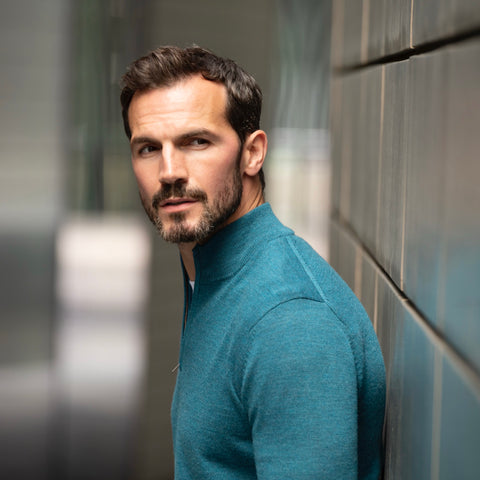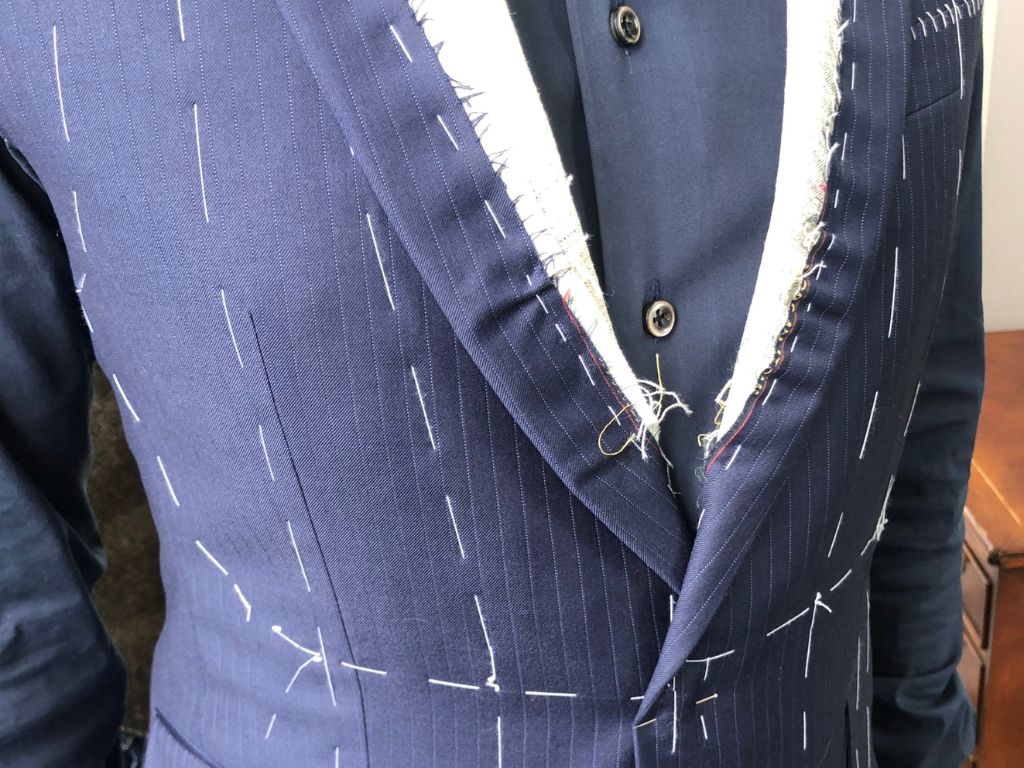We love knitwear here at Alexandra Wood and it’s set to be this season’s stylish wardrobe go-to piece of clothing.
Where you’d have previously only worn a sweater on a super chilly day; it has now become a style icon of its own. Ideal for layering (which if you don’t know – means adding a few lighter layers to create a look where you can add on, or take off an item of clothing, depending on how hot, or cold you feel. Plus, it looks pretty stylish too.
Knitwear is now such a versatile component of a man’s wardrobe and when chosen thoughtfully and styled the right way, a jumper becomes a sophisticated style piece in your sartorial arsenal, rather than something you’ve just thrown on to keep warm when it’s chilly outside.
It’s undeniable that knitwear tends to lean towards the ‘wear at the weekend’ end of the style spectrum. However, this guide will walk you through how you can wear knitwear for various occasions, even as a smart alternative to your standard button-down shirt.
Where did men’s knitwear originate?
The humble jumper started life as a functional item of clothing for fishermen: life on the cold seas demanded a warm, hard-wearing garment. As early as the 15th century, fisherman’s wives across the British Isles and France made tightly knitted ‘guernseys’ from unscoured wool that repelled the sea spray.
In the mid-19th century, the ‘gansey’ (as it was later called) was incorporated into the Royal British Navy’s uniform. Around the same time, the Fair Isle sweater from Scotland and the Aran sweater from Ireland were traded outside their places of production.
Sweaters remained an item of work clothing until 1921 when the trendy Prince of Wales wore a Fair Isle sweater in public, sparking a craze for the design and propelling the sweater into the realms of men’s fashion.
Soon after, playwright Noel Coward made turtlenecks famous (Note, you’ll occasionally have me ranting about that fact that I don’t like turtlenecks and far prefer roll necks) for the artistic community. By the 1950’s sweaters, including the popular-again Aran style, were being exported and worn by stars such as Errol Flynn, Steve McQueen and Michael Cain, cementing them as a wardrobe staple for men around the world.
Which one is correct – knitwear, jumper, sweater or pullover?
Potatas, potatoes. They actually all mean the same thing – it just depends on where you live.
In the UK, we generally favour the term jumper. The American term sweater can bring up connotations of sweatshirts and tracksuits, but it is increasingly being adopted as the catch-all term for long-sleeved clothing items that have no/few buttons to close at the upper chest or neck. A pullover is just a way of describing a knitted item of clothing that you need to pull over your head to get on.
We use knitwear as a broader term that encompasses sweaters/jumpers in all their varieties, cardigans, and knitted long and short-sleeve tops made from a knitted rather than woven fabric. We tend to exclude items made from fleece and sweatshirts in this category.
What is the best material for a jumper?

Regardless of style, choose knitwear made with pure, high-quality natural fibres such as wools as they allow your body to breathe. Synthetic fibres such as polyester may seem more practical from a care perspective as you can throw them in the washing machine. Still, they trap heat which is uncomfortable at best and causes overheating at worst. As most will know; I can’t stand synthetic fabrics for a multitude of reasons, not to mention that far too many well-known brands short change customers by charging a premium for a less than premium product- always check your fabric labels. You will never see me designing any collection that hasn’t been made from the purest of fabrics.
Furthermore, knitwear made from natural fibres keeps its shape far better in the long run and is more likely flattering to your physique. Synthetic fabrics lose shape, (and feel prettt awful) so by the end of winter, you’ll end up looking like a sack of potatoes.
My picks are:
Which men’s knitwear style should you choose?

Style comes down to preference, but to make shopping easier, it’s handy to know which collar style suits you best.
Guide to knitwear collar styles
For the majority of sweaters, the collar will dictate what style it is.
Crew neck
Roll neck
V-Neck
Fittingly named because the neckline is cut in a “V” shape. This style works well with a collared shirt and tie for the office.
Unique patterns or design features define other styles, such as:
Whether you choose a lightweight or chunky knit mainly comes down to comfort.
For those transitional months between seasons and cool summer evenings, a lightweight crew or V-neck jumper in merino wool with a flat or jersey knit is a great choice. Just pop it over a simple t-shirt or even wear it on its own.
As we descend into the depths of winter, you’ll need thicker options. Look for chunky cable or Aran knit, or even a moss stitch jumper that you can layer under your coat.
What you intend wearing over your knitwear will also have some bearing on your choice – more delicate knits work better under sports jackets, whereas you may be able to fit a chunkier knit under an overcoat.
How should my jumper or sweater fit?
An oversized sweatshirt is great for lounging in front of the television. But that’s precisely where loose-fitting jumpers belong – at home.
We’re big believers that everything should be close fitting but not tight. This philosophy applies to all body shapes and sizes as it is the most flattering type of fit. The bulk created by excess fabric simply draws more attention to your mid-section and won’t allow for a jacket or coat to sit nicely over the jumper.
Here’s how to tell if your knitwear fits correctly:
Shoulders
The shoulder seam should gently hug the edge of your shoulders as this will give your frame a clean, crisp appearance. Shoulder seams that are either too tight or too wide tend to be unflattering as they lack the sharp edge that your body needs for a neat look.
Sleeves
Make sure that your sleeves end just after your wrist bone and slightly cup your hands. If the sleeves sit any higher, the sweater is too small, but if the cuffs cover your hands, you’ll look like a teenager wearing their dads jumper.
Waistline
Most knitwear has no shape and what we see is key to both a stylish and flattering look. At Alexandra Wood it’s our signature style to create clothing that is cut to flatter, and this follows through to our knitwear. Lines that run straight up and down beside the body aren’t attractive.
Length
There is usually a cuff of some description at the bottom of a jumper or knitted top – traditionally made with a rib stitch. We advise tucking this under before you assess the length of the item. It should sit around your hips. Cue the word ‘zhuzh’ which means to make an improvement by a slight adjustment. I’m constantly nonchalantly ‘lifting and puffing up’ a man’s sweater to make it look cooler. Why I hear you ask… It’s because every man I know pulls their sweater down to its full length but not its full potential. Pulled straight down looks like it’s not a part of you, plus it accentuates the stomach area. With a slight tweak, it looks far more stylish. Give it a go!
How to wear your knitwear

You’re probably an expert at the plain shirt – fine knit – trouser combo for business casual, but there are a few other options to consider:
Once you have your outfit sorted, there’s the matter of a cuff at the bottom of all sweaters. Most men seem to pull this straight down straight, making the jumper look unbalanced and creates a firm line between the torso and the trousers. We always suggest tucking that part underneath to blur the lines between the tummy and the trouser waistline to soften your silhouette.
How to layer with men’s knitwear
If you live in a temperate or cold climate, layering is a necessary skill. The trick is to purchase items that layer well together.
Before you go shopping, think about what you’ll wear over your knitwear, such as a roomy overcoat or a fitted jacket. For example, if your coat has slim sleeves, a chunky knit may fit, but it may be impossible to lift your arms. Here, a lighter weight knit will feel more comfortable.
Also considered how fitted your outwear is around the waist – the thicker fabric of a chunky knit may make it difficult to do up a zip or buttons and make you look heavier than you are.
Finally, layering also includes accessories like scarves. Wearing a scarf over a knit with a high neckline would be overkill, whereas a fine knit with a V-neck or crew neck layered with a scarf and tailored overcoat looks wonderfully smart. Avoid too many textures with your scarves and knitwear, also. A cable-knit jumper paired with a cable-knit scarf is a little too much for anyone!
How should I care for my knitwear?
Before you do anything, read the care instructions on the label.
We cannot stress this enough!
Washing instructions can vary between garments, even if the same brand sells them, so don’t assume you can treat two different jumpers the same way. That said, you’ll find instructions generally include a variation of these steps:
We advise customers to refrain from washing their knitwear too often as this can stress the fibres and reduce the item’s longevity. Wearing a t-shirt or shirt underneath knitwear will help you extend the time between washes.
You may like to purchase a pilling device to gently scrape away those annoying bobbles of fluff and keep your knitwear looking new.




